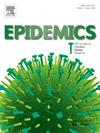利用非参数霍克斯模型检测 SARS-Cov-2 的激增
IF 2.4
3区 医学
Q2 INFECTIOUS DISEASES
引用次数: 0
摘要
霍克斯点过程模型已被证明能高精度地预测包括 SARS-CoV-2 (Covid-19)在内的流行性疾病的每日新增病例数。在此,我们探讨了霍克斯模型预测美国 Covid-19 突增病例的准确性。我们使用霍克斯模型估计了美国 50 个州中每个州的 Covid-19 病例数的有效繁殖率 Rt 和传播密度参数,然后用简单的指数平滑法预测了未来几周的 Rt。基于 Rt>x 的分类器仅使用截至 2020 年 8 月至 2021 年 12 月的数据预测每周即将出现的病例激增。在误报率低于 5%的情况下,基于 Rt 的预测比基于平滑原始病例数数据的预测更准确,Rt>1.39 的最高准确率达到 90%。最佳决策边界使用 Rt 和观测数据的组合。本文章由计算机程序翻译,如有差异,请以英文原文为准。

Detection of surges of SARS-Cov-2 using nonparametric Hawkes models
Hawkes point process models have been shown to forecast the number of daily new cases of epidemic diseases, including SARS-CoV-2 (Covid-19), with high accuracy. Here, we explore how accurately Hawkes models forecast surges of Covid-19 in the United States. We use Hawkes models to estimate the effective reproduction rate and transmission density parameters for Covid-19 case counts in each of the 50 United States, then forecast in future weeks with simple exponential smoothing. A classifier based on is applied to predict upcoming surges in cases each week from August 2020 to December 2021, using only data available up to that week. At false alarm rates below 5%, the forecasts based on are correct more often than forecasts based on smoothing the raw case count data, achieving a maximum accuracy of 90% with . The optimal decision boundary uses a combination of and observed data.
求助全文
通过发布文献求助,成功后即可免费获取论文全文。
去求助
来源期刊

Epidemics
INFECTIOUS DISEASES-
CiteScore
6.00
自引率
7.90%
发文量
92
审稿时长
140 days
期刊介绍:
Epidemics publishes papers on infectious disease dynamics in the broadest sense. Its scope covers both within-host dynamics of infectious agents and dynamics at the population level, particularly the interaction between the two. Areas of emphasis include: spread, transmission, persistence, implications and population dynamics of infectious diseases; population and public health as well as policy aspects of control and prevention; dynamics at the individual level; interaction with the environment, ecology and evolution of infectious diseases, as well as population genetics of infectious agents.
 求助内容:
求助内容: 应助结果提醒方式:
应助结果提醒方式:


